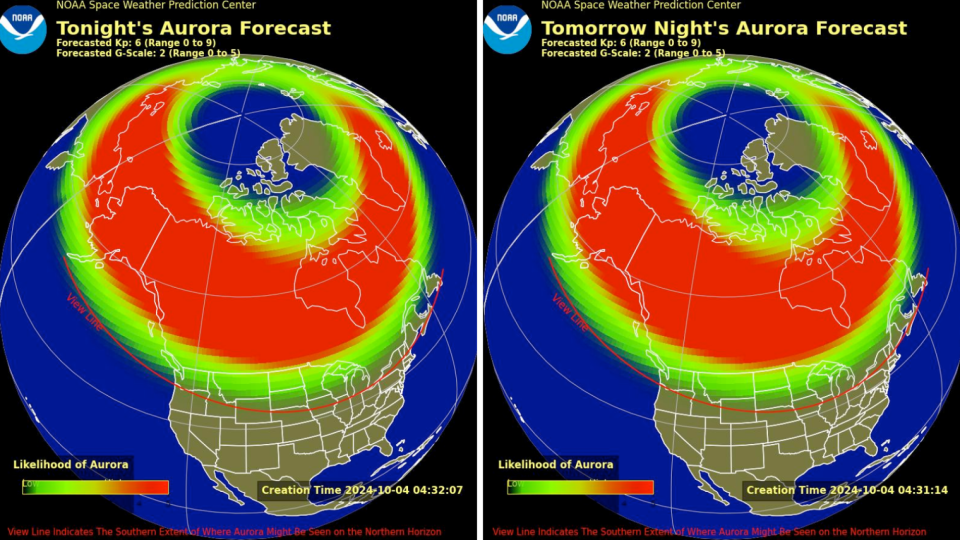The Northern Lights are set to make another appearance over the next few days, bathing the sky over the U.S.-Canadian border in a beautiful display of colour. Here’s how you can view the aurora borealis’ amazing natural light show.
SEE ALSO: Footage shows return of colossal sunspot that created Northern Lights
According to the U.S. National Oceanic and Atmospheric Administration’s Space Weather Prediction Center (SWPC), northern U.S. states may be able to see the Northern Lights from Oct. 4, with the display expected to persist until Oct. 6. Some of the lower Midwest to Oregon might also catch a glimpse of the aurora borealis, though odds improve toward the top end of the country.
This weekend’s aurora is a result of strong G3 geomagnetic storms predicted to arrive at Earth over the next three days, with the SWPC having issued Geomagnetic Storm Watches until Sunday. Fortunately, these storms should be more dazzling than disruptive. Though geomagnetic storms can cause issues such as power outages and radio disruption, the SWPC predicts that the “limited, minor effects to some technological infrastructure” which may occur during these particular storms will be “mainly mitigatable.” As such, you can enjoy gazing at the Northern Lights without any worries.
How to get the best view of the Northern Lights


Credit: The National Oceanic and Atmospheric Administration’s Space Weather Prediction Center
Though you can’t control the weather or cloud cover obscuring the Northern Lights, you can take some steps to ensure you get the best view possible.
First, you should check that you’re looking up at the right time. Searching for the Northern Lights before sunset will leave you disappointed, as auroras aren’t clearly visible during the day. Instead, you should try at night when the dark sky provides the Northern Lights with a contrasting backdrop. According to the SWPC, the best viewing time for an aurora borealis is between 10 p.m. and 2 a.m.
You should also try to view the aurora from somewhere with as little light pollution as possible. If you’re willing to travel, a certified Dark Sky Place close to the U.S.’ border with Canada should give you excellent visibility. These locations have been independently reviewed and recognised as having minimal light pollution, allowing for some of the best possible views of the night sky.
Even if you can’t travel to one of these areas, you should still go out and look up anyway. When conditions are right, auroras can be visible from over 600 miles away.
What causes auroras?
While auroras can also be caused by solar flares, we can thank coronal mass ejections for this particular display. As the name suggests, a coronal mass ejection is when the Sun expels significant amounts of plasma and magnetic field from its corona, the outermost layer of its atmosphere.
The resulting solar wind then travels toward Earth, though it can take some time to arrive. Even the fastest coronal mass ejections can take most of a day to get here, while radiation from solar flares can arrive in as little as eight minutes.
Upon arrival, the majority of the solar wind is deflected away from Earth courtesy of the planet’s magnetic field. Not all of it is sent back out into space though, with some charged ion particles entering said field instead. Such particles travel to Earth’s polar regions where the magnetic field is weakest, colliding with oxygen and nitrogen atoms once there.
This chemical reaction creates the colourful lights that make up an aurora. If it’s located in the Northern Hemisphere it’s called an aurora borealis, while those in the Southern Hemisphere are called aurora australis.
